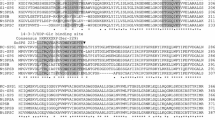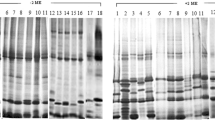Abstract.
Isoamylase (EC 3.2.1.68) in rice (Oryza sativa L.) was efficiently purified within a day to homogeneity, as confirmed by sodium dodecyl sulfate-polyacrylamide gel electrophoresis (SDS-PAGE), from developing endosperm by sequential use of Q Sepharose HP anion- exchange chromatography, ammonium sulfate fractionation, and TSKgel G4000SWXL and G3000SWXL gel filtration chromatography. Although the protein exhibited a molecular size of ca. 83 kDa on SDS-PAGE, the apparent size of the native enzyme was approximately 340 and 490 kDa on TSKgel G3000SWXL and G4000SWXL gel filtration chromatograms, respectively, suggesting that rice isoamylase exists in a homo-tetramer to homo-hexamer form in developing endosperm. The purified rice isoamylase was able to debranch glycogen, phytoglycogen and amylopectin but could not attack pullulan. The optimum pH and temperature for isoamylase activity were found to be pH 6.5 to 7.0 and 30 °C, respectively. The enzyme activity was completely inhibited by HgCl2 and p-chloromercuribenzoate at 1 mM. These results indicate that rice isoamylase possesses properties which are distinct from those reported for bacterial isoamylase. Complementary-DNA clones for rice endosperm isoamylase were isolated with a polymerase-chain-reaction product as probe which was generated by primers designed from nucleotides conserved in cDNA for maize Sugary-1 isoamylase (M.G. James et al., 1995, Plant Cell 7: 417–429) and a Pseudomonas amyloderamosa gene encoding isoamylase (A. Amemura et al., 1988, J Biol Chem 263: 9271–9275). The nucleotide sequence and deduced amino acid sequence of the longest clone showed a high similarity to those of maize Surgary-1 isoamylase, but a lesser similarity to those of Pseudomonas amyloderamosa isoamylase. Southern blot analysis and gene mapping analysis indicated that the isoamylase gene exists as a single copy in the rice genome and is located on chromosome 8 of cv. Nipponbare which belongs to the Japonica rice group. Phylogenetic analysis indicated that isoamylases from maize and rice are more closely related to a number of glgX gene products of the blue green alga Synechocystis and various bacteria than to isoamylases from Pseudomonas and Flavobacterium. Hence, it is proposed that glgX proteins are classified as isoamylase-type debranching enzymes. Our tree also showed that all starch- and glycogen-debranching enzymes from plants and bacteria tested can be classified into two distinct types, an isoamylase-type and a pullulanase-type.
Similar content being viewed by others
Author information
Authors and Affiliations
Additional information
Received: 29 October 1998 / Accepted: 10 December 1998
Rights and permissions
About this article
Cite this article
Fujita, N., Kubo, A., Francisco, P. et al. Purification, characterization, and cDNA structure of isoamylase from developing endosperm of rice. Planta 208, 283–293 (1999). https://doi.org/10.1007/s004250050560
Issue Date:
DOI: https://doi.org/10.1007/s004250050560




